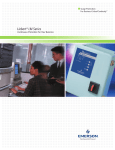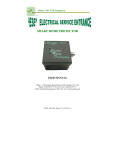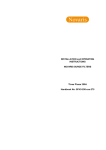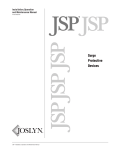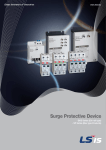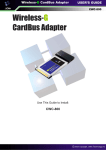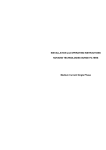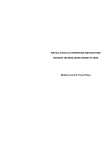Download Best Power B510-0600U Installation manual
Transcript
500 Series 510 Surge Protective Device Installation, Operation and Maintenance Manual Surge Protective Devices EMERSON NETWORK POWER SURGE PROTECTIVE DEVICE INSTALLATION, OPERATION AND MAINTENANCE MANUAL TABLE OF CONTENTS UNPACKING AND INSTALLATION Unpacking and Preliminary Inspection . . . . . . . . . . . . . . . . . . . . . . . . . . . . . . . . . . . . . . . . . . . . . . . . . . . . . . . . . . . . . . . . . . 2 Handling Considerations . . . . . . . . . . . . . . . . . . . . . . . . . . . . . . . . . . . . . . . . . . . . . . . . . . . . . . . . . . . . .. . . . . . . . . . . . . . . . 2 Storage. . . . . . . . . . . . . . . . . . . . . . . . . . . . . . . . . . . . . . . . . . . . . . . . . . . . . . . . . . . . . . . . . . . . . . . . . . . . . . . . . . . . . . . . . . . 2 LOCATION CONSIDERATIONS Environment . . . . . . . . . . . . . . . . . . . . . . . . . . . . . . . . . . . . . . .. . . . . . . . . . . . . . . . . . . . . . . . . . . . . . . . . . . . . . . . . . . . . . . . Audible Noise . . . . . . . . . . . . . . .. . . . . . . . . . . . . . . . . . . . . . . . . . . . . . . . . . . . . . . . . . . . . . . . . . . . . . . . . . . . . . . . . . . . . . . Service Clearances . . . . . . . . . . . . . . . . . . . . . . . . . . . . . . . . . . . . . . . . . . . . . . . . . . . . . . . . . . . . . . . . . . . . . . . . . . . . . . . . . Mounting . . . . . . . . . . . . . . . . . . . . . . .. . . . . . . . . . . . . . . . . . . . . . . . . . . . . . . . . . . . . . . . . . . . . . . . . . . . . . . . . . . . . . . . . . . Warnings Defined . . . . . . . . . . . . . . . . . . . . . . . . . . . . . . . . . . . . . . . . . . . . . . . . . . . . . . . . . . . . . . . . . . . . . . . . . . . . . . . . . . 2 2 2 2 2 MODEL NUMBER CONFIGURATION Model Number Configuration . . . . . . . . . . . . . . . . . . . . . . . . . .. . . . . . . . . . . . . . . . . . . . . . . . . . . . . . . . . . . . . . . . . . . . . . . . 3 Configuration & Voltage (Chart) . . . . . . . . . . . . . . . . . . . . . . . .. . . . . . . . . . . . . . . . . . . . . . . . . . . . . . . . . . . . . . . . . . . . . . . . 3 ELECTRICAL CONNECTIONS Voltage Ratings and Power Source Configurations . . . . . . . . . . . . . . . . . . . . . . . . . . . .. . . . . . . . . . . . . . . . . . . . . . . . . . . . . Wire Connections . . . . . . . . . . . . . . . . . . . . . . . . . . . . . . . . . . . . . . . . . . . . . . . . . . . . . . . . . . . . . . . . . . . . . . . . . . . . . . . . . . Over Current Protection . . . . . . . . . . . . . . . . . . . . . . . . . . . . . . . . . . . . . . .. . . . . . . . . . . . . . . . . . . . . . . . . . . . . . . . . . . . . . . NEC Considerations . . . . . . . . . . . . . . . . . . . . . . . . . . . . . . . . . . . . . . . . . .. . . . . . . . . . . . . . . . . . . . . . . . . . . . . . . . . . . . . . . Voltage Protection Ratings . . . . . . . . . . . . . . . . . . . . . . . . . . . . . . . . . . . . . . . . . . . . . . . . . . . . . . . . . . . . . . . . . . . . . . . . . . Circuit Ampacity Limitations . . . . . . . . . . . . . . . . . . . . . . . . . . . . . . . . . . . . . . . . . . . . . . . . . . . . . . . . . . . . . . . . . . . . . . . . . . System Grounding and Bonding . . . . . . . . . . . . . . . . . .... . . . . . . . . . . . . . . . . . . . . . . . . . . . . . . . . . . . . . . . . . . . . . . . . . . Parallel Connections . . . . . . . . . . . . . . . . . . . . . . . . . . . . . . . . . . . . . . . . . . . . . . . . . . . . . . . . . . . . . . . . . . . . . . . . . . . . . . . . Grounding Electrode . . . . . . . . . . . . . . . . . . . . . . . . . . . . . . . . . . . . . . . . . . . . . . . . . . . . . . . . . . . . . . . . . . . . . . . . . . . . . . . . Neutral Connection . . . . . . . . . . . . . . . . . . . . . . . . . . . . . . . . . . . . . . . . . . . . . . . . . . . . . . . . . . . . . . . . . . . . . . . . . . . . . . . . . 4 4 4 4 4 4 4 5 5 5 INSTALLATION INSTRUCTIONS Product Installation . . . . . . . . . . . . . . . . . . . . . . . . . . . . . . . . . . . . . . . . . . . . . . . . . . . . . . . . . . . . . . . . . . . . . . . . . . . . . . . . . . NEMA 12 (Metal) Enclosure Option. . . . . . . . . . . . . . . . . . . . . . . . . . . . . . . . . . . . . . . . .. . . . . . . . . . . . . . . . . . . . . . . . . . . . . NEMA 4X (Non-Metallic) Enclosure Option . . . . . . . . . . . . . . . . . . . . . . . . . . . . . . . . . . . . . . . . . . . . . . . . . . . . . . . . . . . . . . . NEMA 1 Panelboard Extension Enclosure Option . . . . . .. . . . . . . . . . . . . . . . . . . . . . . . . . . . . . . . . . . . . . . . . . . . . . . . . . . 6 7 7 8 MONITORING FEATURES External Status Indicators (Standard) . . . . . . . . . . . . . . . . . . . . . . . . . . . . . . . . . . . . . . . . . . . . . . . ................ 9 Audible Alarm (Standard/Optional) . . . . . . . . . . . . . . . . . . . . . . . . . . . . . . . . . . . . . . . . . . . . . . . . . . . . . . . . . . . . . . . . . . . . . 9 Summary Alarm Contact (Standard/Optional) . . . . . . . . . . . . . . . . . . . . . . . . . . . . . . . . . . . . . . . . . . . . . . . . .. . . . . . . . . . . 9 Transient Counter (Optional) . . . . . . . . . . . . . . . . . . . . . . . . . . . . . . . . . . . . . . . . . .. . . . . . . . . . . . . . . . . . . . . . . . .. . . . . . . 9 TROUBLESHOOTING/SERVICING/MAINTENANCE Troubleshooting . . . . . . . . . . . . . . . . . . . . . . . . . . . . . . . . . . . . . . . . . . . . . . . . . . . . . . . . . . . . . . . . . . . . . . . . . . . . . . . . . . . 9 Servicing . . . . . . . . . . . . . . . . . . . . . . . . . . . . . . . . . . . . . . . . . . . . . . . . . . . . . . . . . . . . . . . . . . . . . . . . . . . . . . . . . . . . . . . . . 9 Corrective Maintenance . . . . . . . . . . . . . . . . . . . . . . . . . . . . . . . . . . . . . . . . . . . . . . . . . . . . . . . . . . . . . . . . . . . . . . . . . . . . . . 9 Preventative Maintenance . . . . . . . . . . . . . . . . . . . . . . . . . . . . . . . . . . . . . . . . . . . . . . . . . . . . . . . . . . . .. . . . . . . . . . . . . . . . 9 Installation, Operation and Maintenance Manual 1 IO-70103 Rev 0, 1/2013 Surge Protective Devices LOCATION CONSIDERATIONS UNPACKING AND INSTALLATION Unpacking and Preliminary Inspection 1. Inspect the shipping crate(s) for damage or signs of mishandling before unpacking the unit. 2. Remove any securing bands and cardboard packing and inspect the unit for any obvious shipping damages. 3. If any damage as a result of shipping is observed, immediately file a claim with the shipping agency and forward a copy to your local Emerson Network Power Surge Protection Sales Representative. For optimum transient surge protection, coordinated surge suppression should be applied at the service entrance and all other electrical connections to the building (telephone, CATV, etc.), at known surge generating loads within the building (large motors, arc welders, switched capacitors, etc.), as well as at sensitive electronic loads (such as computers, electronic appliances, solid state motor drives, etc.). For interconnected electronic loads (such as by way of data cabling), transient surge suppression should also be applied to the interconnecting wiring (data cables). Environment Unit is designed for operation indoors in ambient temperatures of -40ºC (-40ºF) to +60ºC (+140ºF) with a relative humidity of 0% to 95% (non-condensing). Handling Considerations Larger units are bolted to a shipping pallet to facilitate handling by forklift or pallet jack. Check the size and weight. Refer to the cabinet data furnished with the unit. Storage The unit should be stored in a clean, dry environment. Storage temperature range is -55ºC (-67ºF) to +85ºC (+185ºF). Care should be taken to avoid condensation. All packing and shipping materials should be left intact until the unit is ready for final installation. If the unit has been stored for an extended period of time, the unit should be cleaned and carefully inspected before placing into service. The unit is provided in an industrial use enclosure, which is dust-tight and drip-tight and should not be installed in areas with excessive dust, corrosive vapors, flammable materials or explosive atmospheres. Audible Noise The audible noise of the unit is less than 40 dB at 5 feet, which allows its placement within almost any room if desired. Service Clearances Service clearance is needed for units with hinged doors on the front that are capable of being opened. Thirty-six inches (36 in/914 mm) minimum is recommended. Mounting Unit is intended to be wall mounted. Refer to installation instructions for mounting dimensions and weight. Warnings Defined Danger: Indicates an imminently hazardous situation that, if not avoided, will result in death or serious injury. This signal word is to be limited to the most extreme situations. Warning: Indicates a potentially hazardous situation that, if not avoided, could result in death or serious injury. Caution: Indicates a potentially hazardous situation that, if not avoided, may result in minor or moderate injury. It may also be used to alert against unsafe practices. Installation, Operation and Maintenance Manual 2 IO-70103 Rev 0, 1/2013 Surge Protective Devices MODEL NUMBER CONFIGURATION Model #: _ _ _ _ _ _ _ _ _ _ _ _ _ 1 2 3 4 (1-3) Series 510 = Modular/Non-Modular MOV (4-5) Configuration & Voltage See Chart Below (6-7) Surge Rating Per Mode 06 = 65kA 08 = 80kA 10 = 100kA 12 = 125kA 16 = 160kA 20 = 200kA 25 = 250kA Installation, Operation and Maintenance Manual 5 6 7 8 9 (8) Modes of Protection A = All Modes of Protection B = L-N & N-G E = L-L F = L-N G = L-G (9) Connection Type N = Wiring terminals/Lugs R = Rotary Disconnect Switch W = Wire Leads (10) Monitoring Options R = LED/Relay A = LED/Alarm/Relay C = LED/Alarm/Counter/Relay 3 10 11 12 13 (11) Enclosure R = Type 3R (metal) G = Type 4 (metal) H = Type 4X (Stainless Steel) J = Type 4X (Non-Metallic) L = Type 12 (metal) F = Panelboard Flush (metal) S = Panelboard Surface (metal) (12) UL 1449 Type 0 = No UL 1 = Type 1 2 = Type 2 (13) MOV Option S= Standard Q = High Rated IO-70103 Rev 0, 1/2013 Surge Protective Devices ELECTRICAL CONNECTIONS All electrical connections should be installed by a qualified (licensed) electrician only. All wiring must comply with the National Electrical Code (NEC) and applicable local codes. VERIFY THAT ALL POWER CIRCUITS ARE DE-ENERGIZED AND LOCKED OUT BEFORE MAKING ELECTRICAL CONNECTIONS. Voltage Ratings and Power Source Configurations Before making connections to the unit, verify that the unit model number and nameplate voltage rating are appropriate for connection to the intended power source. See the chart on page 3 for voltage rating applications with typical power source configurations. Wire Connections With parallel connection, the size of the wiring to the SPD unit is independent of the protected circuit s ampacity. NEC Article 285-21(B) requires surge suppressor connecting conductors to be at least #14 copper or #12 aluminum. To reduce the wiring impedance to surge currents, it is recommended that the phase, neutral (if required), and ground conductors are twisted together and routed in the same raceway (conduit). Avoid any sharp bends in the conductors. Overcurrent Protection The SPD unit conducts practically no current under normal operation and only conducts very short duration transient surge currents. NEC Considerations - The following is from the National Electric Code 2008 Edition. NEC 285.21 Connections NEC 285.23 Type 1 SPD s. Shall be installed in accordance with 285.35(A) and (B). (A) Installation. Type 1 SPD s shall be installed as follows: (1) Type 1 SPD s shall be permitted to be connected to the supply side of the service disconnect as permitted in 230.82(4) or (2) Type 1 SPD s shall be permitted to be connected in Type 2 locations as specified in 285.24. (B) At the service. When installed at the services, the grounding conductor of a Type 1 SPD shall be connected to one of the following: Installation, Operation and Maintenance Manual (1) Grounded service conductor (2) Grounded electrode conductor (3) Grounding electrode for service (4)Equipment grounding terminal in the service equipment Voltage Protection Ratings To obtain the voltage protection ratings (VPR s), as obtained by Underwriters Laboratory, Incorporated, in accordance with the Standard for Safety, Surge Protective Devices (SPD s), Standard 1449, Third Edition, released (2009), marked on this product, the wire size listed for each product must be utilized to connect the unit to your facilities power grid. Connections made with conductors other than the wire size listed may result in different VPR s. Circuit Ampacity Limitations Representative samples of these products have been investigated by Underwriters Laboratories, Incorporated to withstand, without exposing live circuits or components at system voltages and fault currents up to 200,000 AIC, as described in the Standard for Safety, Surge Protective Devices (SPD s), Standard 1449, Third Edition, released (2009). System Grounding and Bonding The performance and safety of any SPD system is dependent on proper grounding and bonding. Grounding is required for safety. Correct implementation also enhances equipment performance. Incorrect grounding can reduce or impede the SPD s operation. All electrical circuits to the SPD must include an equipmentgrounding conductor as required by the NEC and local codes. UNGROUNDED POWER SYSTEMS ARE INHERENTLY UNSTABLE AND CAN PRODUCE EXCESSIVELY HIGH LINE-TO- GROUND VOLTAGES DURING CERTAIN FAULT CONDITIONS. DURING THESE FAULT CONDITIONS ANY ELECTRICAL EQUIPMENT, INCLUDING AN SPD, MAY BE SUBJECTED TO VOLTAGES WHICH EXCEED THEIR DESIGNED RATINGS. THIS INFORMATION IS BEING PROVIDED TO THE USER SO THAT AN INFORMED DECISION CAN BE MADE BEFORE INSTALLING ANY ELECTRICAL EQUIPMENT ON AN UNGROUNDED POWER SYSTEM. CONTACT FACTORY FOR UNGROUNDED APPLICATIONS. An insulated grounding conductor is required in addition to any metallic raceway, which may be used as a grounding conductor. For parallel-connected SPDs, the grounding conductor should be the same wire size as the associated power conductors. 4 IO-70103 Rev 0, 1/2013 Surge Protective Devices PARALLEL CONNECTIONS Typical Parallel Connections (without Internal Rotary Disconnect) Typical Parallel Connections (with Internal Rotary Disconnect) Neutral Phases Ground Neutral Phases Ground To Protected Loads To Protected Loads Neutral Phase(s) Surge Protective Device Neutral Transient Ground Protected Panel Wire should be less than 5 feet and straight as possible Rotary Disconnect Safety Ground Surge Protective Device Transient Ground Protected Panel Grounding conductors must be routed with the associated power conductors in the same raceway (conduit). When metallic raceways are used, adequate electrical continuity must be maintained at all raceway connections, particularly raceway terminations to the electrical enclosures. Wire should be less than 5 feet and straight as possible Safety Ground For proper SPD performance, the service entrance grounding electrode system must comply with the NEC by having all available electrodes (building steel, metal water pipe, driven rods, concrete encased electrodes, etc.) properly bonded together and connected to the power system grounding. The use of isolating bushings or other means to interrupt a metallic conduit run is a potential safety hazard and is not recommended. The use of a separate grounding electrode to ground the SPD defeats the effectiveness of the SPD, is a potential safety hazard, may cause equipment damage, is an NEC violation (reference NEC 250-51 and 250-54), and is not recommended. Grounding Electrode Surge protective devices do not discharge all surges to ground (earth). Surge protective devices can also divert the surge current back to its source to complete the electrical circuit. In the case of lightning whose potential is developed with respect to the earth, the SPD diverts the surge current to the grounding electrode (earth connection). However, for most transient surges that are developed by switching loads, the SPD diverts the surge current back to its source without involving the grounding electrode. Installation, Operation and Maintenance Manual Phase(s) Neutral Connection FOR PROPER AND SAFE OPERATION, THE SPD s NEUTRAL, MUST BE RELIABLY CONNECTED TO THE NEUTRAL OF THE SOURCE. FAILURE TO PROVIDE A RELIABLE NEUTRAL CONNECTION MAY RESULT IN FAILURE! 5 IO-70103 Rev 0, 1/2013 Surge Protective Devices INSTALLATION INSTRUCTIONS The Emerson Network Power 510 Series Surge Protective Devices (SPDs) are high quality, high energy surge current diversion systems designed to protect sensitive equipment from damaging transient voltage surges. Proper installation is required for maximum system performance. 6. Apply power. The surge protector is fully operational when the GREEN LED s on the modules (when applicable), and the front of the enclosure are illuminated. If the GREEN LED s are extinguished or a RED LED is illuminated, check to ensure that power is applied to the SPD. If an abnormal indication is present, remove power to the SPD and contact Emerson Network Power Surge Protection at 1-800-2886169 or 1-607-721-8840. The installer should perform the following steps to assure a quality installation. The entire installation manual should be read before starting installation. These instructions do not replace national or local electrical codes. Check applicable electrical codes to ensure compliance. Installation of the SPD system should only be performed by qualified personnel. 7. Periodically monitor the status of the LED s. Reduced protection exists if the GREEN LED s are extinguished or the RED LED is illuminated. Please contact Emerson Network Power Surge Protection at 1-800-2886169 or 1-607-721-8840. 1. Insure that all power is removed before beginning installation. A qualified licensed electrician shall install all electrical connections. 8. The protection modules in these SPD s may be replaceable, contact Emerson Network Power Surge Protection for replacement. 2. The standard SPD is provided in a NEMA 1 (indoor), NEMA12 (indoor) or NEMA 4X (outdoor) rated enclosures suitable for use in indoor or outdoor installations. Verify the SPD enclosure rating by referencing position 11 in the Model Number Configuration tool on page 3. 3. Determine where the SPD is to be mounted, allowing for minimum length of wire between itself and the input power terminals of the service panel. Punch or cut the proper hole size in the side of the SPD closest to the knockout to be utilized in the service panel. (NEMA 4X plastic enclosure units include a flexible conduit/nipple accessory no punching/drilling required in SPD) Drill mounting holes in wall at location picked for SPD next to service panel using mounting dimensions shown in the table below. Mount surge suppressor to wall using appropriate size & type mounting hardware. If the SPD model is a Wye configured unit (4W+G), and a Neutral connection is not available, please contact factory. 4. Connect black wires (line or phase) marked L1/A, L2/B or L3/C, the white wire (neutral) marked N, and the green wire (ground) marked G, of the SPD using the wire range listed below. To yield the best performance of the SPD within the electrical distribution system, keep all conductors as short as possible and avoid sharp bends. 5. Connection to the unit s summary alarm contacts shall be with #18 22 AWG. The ratings of the Form C contacts are 5 amps at 250 VAC maximum with a power factor of 1.0. For additional information, see Monitoring section. Installation, Operation and Maintenance Manual 6 IO-70103 Rev 0, 1/2013 Surge Protective Devices NEMA 12 (Metal) Enclosure Option SUGGESTED CIRCUIT BREAKER AND WIRE SIZE Allowable Range Surge Rating Per Mode 60kA-80kA 100kA-160kA 200kA-250kA Factory Suggested Size Connection Wire Size Circuit Breaker Size With Disconnect Without Disconnect With Disconnect Without Disconnect 40A-150A 15A-100A #8-1/O #14-#2 Circuit Breaker Size 40 Amp 40 Amp 100 Amp Connection Wire Size #8 AWG #8 AWG #2 AWG DIMENSIONAL INFORMATION Surge Rating Per Mode 60kA-80kA 100kA-160kA 200kA-250kA A B C D E F Weight 16 (406) 14 (356) 8 (203) 16.8 (426) 12 (305) 0.31 (8) 20 (508) 16 (406) 9 (229) 21.3 (540) 10 (254) 0.44 (11) 32 lb. (14.5 kg) 41 lb. (18.6 kg) 56 lb. (25.4 kg) C E Summary Alarm Contacts Connection shall be with #18 22 AWG. Form C contacts are rated 5 amps at 250 VAC max. A (Located on PCB behind monitoring panel) D F B NEMA 4X (Non-Metallic) Enclosure Option Overcurrent Protection (Circuit Breaker): Allowable Range: 15A - 30A Suggested Size: 30A Connection Wire: Allowable Range: #14 - #10 Suggested Size: #10 Weight: 6.5 lb. (3 kg) Summary Alarm Contacts Connection shall be with #18 22 AWG. Form C contacts are rated 5 amps at 250 VAC max. NC COM NO Shown with cover removed Installation, Operation and Maintenance Manual 7 IO-70103 Rev 0, 1/2013 Surge Protective Devices NEMA 1 Panelboard Extension Enclosure Option SUGGESTED CIRCUIT BREAKER AND WIRE SIZE Overcurrent Protection (Circuit Breaker): Allowable Range: 15A - 100A Suggested Size: 30A Connection Wire: Allowable Range: #14 - #2 Suggested Size: #10 Weight: 30 lb. (13.6 kg) Summary Alarm Contacts Connection shall be with #18 22 AWG. Form C contacts are rated 5 amps at 250 VAC max. NO COM NC Shown with module cover removed DIMENSIONAL INFORMATION A 18 (457) B 12 (305) C 6 (152) D 11 (279) E 15 (381) F 20.25 (514) G 21.5 (546) (REMOVE COVER FOR ACCESS) A C G (FLUSH) F (SURFACE) E Customer Supplied Panelboard B D 510 Surge Protective Device Panelboard Extension Installation, Operation and Maintenance Manual 8 IO-70103 Rev 0, 1/2013 Surge Protective Devices MONITORING FEATURES Servicing The Emerson Network Power 510 Series comes with a ten year warranty. For servicing assistance, contact your local Sales Representative or Emerson Network Power, Surge Protection at 800-288-6169 or 607-721-8840. External Status Indicators (Standard) These indicators provide a summary of the status of the surge SPD module. For normal conditions, the green OK LED is illuminated and the red Service LED is extinguished. If the surge SPD or module requires replacement, the green OK LED is turned off and the red Service LED illuminated. Audible Alarm (Standard/Optional) If the surge SPD module requires replacement, an audible alarm may be activated to draw attention to the fact that repair service is required to restore the system to normal operation. An audible alarm disable is provided to silence the alarm. The system will automatically reset itself after repair. The audible alarm switch and Service LED can be tested by activating the Test switch on the system monitor panel. ONLY QUALIFIED PERSONNEL SHOULD PERFORM MAINTENANCE ON THE SYSTEM. HAZARDOUS VOLTAGES ARE PRESENT INSIDE THE UNIT DURING NORMAL OPERATIONS. ELECTRICAL SAFETY PRE-CAUTIONS MUST BE FOLLOWED WHEN SERVICING THIS UNIT. Summary Alarm Contact (Standard/Optional) One or two sets of summary alarm Form C relay contacts (N.O. and N.C.) are provided for remote indication of the failed surge SPD module. Contacts are rated 5 amps at 250 VAC maximum with a power factor of 1.0. Access to the contacts is provided via contact terminals located inside of the unit s cover. TO PREVENT RISK OF ELECTRICAL SHOCK, TURN OFF AND LOCK OUT ALL POWER SOURCES TO THE UNIT BEFORE SERVICING UNIT. Corrective Maintenance - The Emerson Network Power 510 Series SPD is designed for years of trouble-free operation. However, even the most reliable equipment may fail under abnormal conditions. Diagnostic indicators are provided to indicate when the unit needs repair or replacement. To ensure continuity of surge protection, failed units should be repaired or replaced at the earliest convenient service opportunity. When replacing surge modules, other components should be inspected for damage and replaced if necessary. Standard electrical troubleshooting procedures should be used to isolate problems other than failed surge current diverter modules. When replacing components, use identically rated components for continued proper operation and safety. Please contact factory for information on replacement parts. Surge Counter (Optional) The surge counter is provided for transient voltage surge monitoring. The counter totalizes line surges monitored since the last time the counter was reset. The circuit counts all surges that deviate from the line sine wave. The factory setting is 30% over nominal line voltage. Other settings include 50%, 70%, and 100%. TROUBLESHOOTING/ SERVICING/ MAINTENANCE Troubleshooting If status failure indication occurs or summary alarm contacts have changed state, a qualified electrician shall first determine if the systems voltage and proper phasing exists. Preventative Maintenance (Inspection and Cleaning) Periodic system inspections, cleaning, and connection checks are recommended to ensure reliable system performance and continued surge transient protection. If the SPD remains in an alarm condition once the electrician is satisfied that the electrical system and its connections are normal, the unit should be repaired. It is difficult to establish a schedule for preventative maintenance since conditions vary from site to site. Inspections for failed surge modules using available diagnostics should be done routinely (weekly or monthly). At this point consult the factory, having available the following information: Unit identification number (refers to the model and serial numbers detailed on the data label and is located on the front of the enclosure.) Nature of problem (including status of all status indicators and alarms). Installation, Operation and Maintenance Manual 9 IO-70103 Rev 0, 1/2013 Surge Protective Devices Installation, Operation and Maintenance Manual 10 IO-70103 Rev 0, 1/2013 Surge Protective Devices Emerson Network Power 100 Emerson Parkway Binghamton, NY 13905 800 288 6169 Phone (U.S. & Canada Only) 607 721 8840 (Outside U.S.) 607 722 8713 FAX United States of America Emerson Network Power European Headquarters Via Leonardo Da Vinci 8 Zona Industriale Tognana 35028 Piove Di Sacco (PD) Italy 39 049 9719 111 Phone 39 049 5841 257 FAX Emerson Network Power Asia Pacific 29/F, The Orient Square Building F. Ortigas Jr. Road, Ortigas Center Pasig City 1605 Philippines +63 2 687 6615 +63 2 730 9572 FAX Technical Support 800 288 6169 Toll-Free 607 721 8840 Phone 607 722 8713 FAX © 2012 Emerson Network Power. All rights reserved throughout the world. Specifications subject to change without notice. IO-70103 Rev 0, (1/2013) Installation, Operation and Maintenance Manual 11 Printed in USA IO-70103 Rev 0, 1/2013













